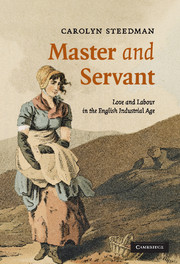Book contents
- Frontmatter
- Contents
- List of maps
- Acknowledgements
- Map 1 Map of the Haworth, Slaithwaite, Huddersfield and Halifax region, 1795
- Map 2 Sketch map of the woollen and worsted producing areas of the West Riding, late eighteenth century
- Prologue
- 1 Introduction: on service and silences
- 2 Wool, worsted and the working class: myths of origin
- 3 Lives and writing
- 4 Labour
- 5 Working for a living
- 6 Teaching
- 7 Relations
- 8 The Gods
- 9 Love
- 10 Nelly's version
- 11 Conclusion: Phoebe in Arcadia
- Bibliography
- Index
Prologue
Published online by Cambridge University Press: 06 January 2010
- Frontmatter
- Contents
- List of maps
- Acknowledgements
- Map 1 Map of the Haworth, Slaithwaite, Huddersfield and Halifax region, 1795
- Map 2 Sketch map of the woollen and worsted producing areas of the West Riding, late eighteenth century
- Prologue
- 1 Introduction: on service and silences
- 2 Wool, worsted and the working class: myths of origin
- 3 Lives and writing
- 4 Labour
- 5 Working for a living
- 6 Teaching
- 7 Relations
- 8 The Gods
- 9 Love
- 10 Nelly's version
- 11 Conclusion: Phoebe in Arcadia
- Bibliography
- Index
Summary
This is a book about one servant and one master and the changing shape of their relationship, lived out in the time and place of the ‘making of the English working class’, the industrial West Riding of Yorkshire. It covers the period from about 1785 when Phoebe Beatson first came to the service of the Reverend John Murgatroyd of Slaithwaite, just outside Huddersfield, to the first decade of the new century, after she had borne her illegitimate child, scandalously, in a clergyman's house. The Anglican God whom Murgatroyd served and promoted throughout his very long life changed His shape and form during these years of war, dearth, revolution and counter-revolution; church and state, the law and its practice, redefined the service relationship, and the human and social relationship ‘service’ inscribed. Here, in what follows, we have one tiny birth pang of modern, industrial society, and some of the minute shifts and stratagems of feeling that countless individuals undertook, in making themselves subjects of modernity.
What I set out to do in this book was explain how its historical actors were able to buck so many of the trends that their historians have seen them – people like them – enacting. Above all I had wanted to understand, and thus be able to explain, why George Thorp refused to marry Phoebe Beatson.
- Type
- Chapter
- Information
- Master and ServantLove and Labour in the English Industrial Age, pp. 1 - 12Publisher: Cambridge University PressPrint publication year: 2007

